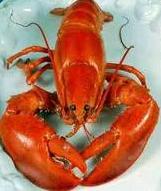
It was on one of the latter trips that we had a traditional New England Clambake. This entailed digging a pit in the sand, and building in it a fire with large logs. When the fire burns down to charcoal, wet seaweed is thrown on top, followed by large quantities of chicken, clams, lobster, and corn on the cob. Note 1 A tarpaulin is then thrown over the top of the whole lot, and everything is allowed to steam over the coals.
Decades later, I was in touch with Peggy by e-mail, and I asked her if she recalled this incident. She replied that she remembered it quite well. I had not only shown her how to remove the lobster for eating, but I had then gone on to explain how to tell if the lobster was male or female, not to eat the brain, what all the internal organs were, all about the liver, and so on. I apparently had gone into so much detail that she started to lose her appetite, and she asked me to stop. Now, anyone who has gotten this far in my blog probably already knows that when expounding on a subject that is near and dear to me, I have been known to go into excessive detail (what current slang often abbreviates as "TMI", meaning "Too Much Information"). Certainly, members of my family are very aware of this propensity. So when I told this story to my sister Phyllis, she found it very amusing. Phyllis then said, "Larry, I think we need a code word to tell you to cut short whatever you are saying, and I think that word should be 'Lobster'." So now, whenever I go on for too long, someone in the know says "Lobster", and I shut up. I've been told by those interested in the childhood stories in my blog that I go on excessively with technical details. Of course, there may be some engineers who are interested, like me, in the history of technology, who wish I wouldn't clutter up my blog with stories from my youth. In any event, this eclectic mix of history, technology, and languages is me - it's what you get. And as Jules Renard said, "Writing is a way of talking without being interrupted" Note 2 - so Hah! you can't "Lobster" me through the computer. But of course, you don't have to. If a story doesn't interest you, just skip it. I'll write more. My daughter Sara has been known to tell a long-winded story or two (apparently, this propensity is genetic), and she revealed to me not long ago that her friends had also generated a stop-phrase for her. She later regretted having told me what it is, so I will certainly not tell it to the world at large. As for the lobster itself, it's a member of the largest animal phylum, the arthropods, which includes insects, spiders, crustaceans, and others. Three out of four of all animals are arthropods. These are invertebrates with an "exoskeleton", meaning their "bones" (so to speak) are on the outside (unlike us, with our bones on the inside). It sure would be easier to mend a broken leg if we were arthropods. We could probably use duct tape. Except because their "skeletons" are heavy, land arthropods can't get really big. Notice that there are no insects the size of an elephant, for instance (imagine a herd of elephant-size cockroaches scurrying across your kitchen floor when you turn on the light). The largest arthropod on land is said to be the coconut crab, which can get up to 40 cm (16 inches) in length. Ah, "But some lobsters can be bigger than that", I hear you cry. Yes, with water providing buoyancy, arthropods underwater can get quite large. Consider the delicious king crab, which can have a leg span of 1.8 meters (6 feet). Issues of scale were discussed in a wonderful 1928 essay by J. B. S. Haldane, entitled "On Being the Right Size". Consider that the weight of a shell increases as the cube of an arthropod's size, but the muscle cross-section only goes up as the square, so as an arthropod gets bigger, it starts having trouble lifting its own weight. You can't just scale things up and down. You need to consider factors such as ... Lobster!   Note 1: What Americans call "corn", the British call "maize". What the British call "corn", we Americans call "wheat". Corn on the cob is a favorite American summer dish, sold all around here at farm stands, freshly picked from adjacent fields. It's a traditional component of a New England Clambake. Through most of their history, the French didn't eat corn, thinking it fit only for animal feed. I personally will eat almost anything, but curiously, I hate the taste of corn. Maybe I should have been born French. [return to text] Note 2: Actually, what he said was, "Ecrire est une manière de parler sans être interrompu". [return to text]  |
 Camp Robinson Crusoe, in Sturbridge, Massachusetts (USA), ran some very nice off-site camping excursions for its older campers (the so-called "Primitive" units), who lived in co-ed groups. These trips generally lasted five days, and included things like a canoe trip down the Connecticut River (from Windsor Locks to Essex), a hike to the summit of Mount Washington (in New Hampshire), and camping on the beaches of Cape Cod and Martha's Vineyard (Massachusetts).
Camp Robinson Crusoe, in Sturbridge, Massachusetts (USA), ran some very nice off-site camping excursions for its older campers (the so-called "Primitive" units), who lived in co-ed groups. These trips generally lasted five days, and included things like a canoe trip down the Connecticut River (from Windsor Locks to Essex), a hike to the summit of Mount Washington (in New Hampshire), and camping on the beaches of Cape Cod and Martha's Vineyard (Massachusetts).
 One of the girls in our group, Peggy Sommerfield (pictured to the right), had apparently never eaten a whole lobster before. Seeing that I knew how to get it out of its shell, she asked me for some tips.
One of the girls in our group, Peggy Sommerfield (pictured to the right), had apparently never eaten a whole lobster before. Seeing that I knew how to get it out of its shell, she asked me for some tips.